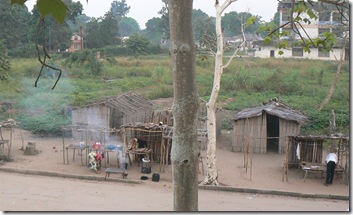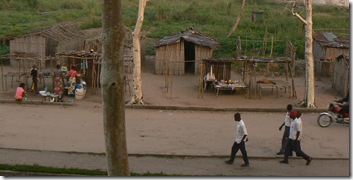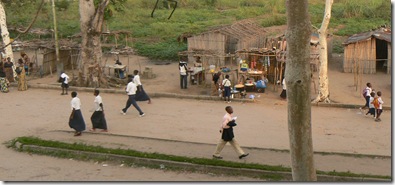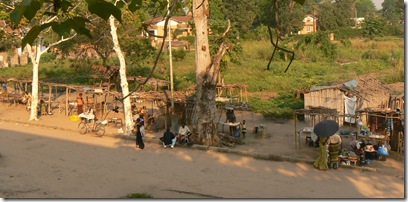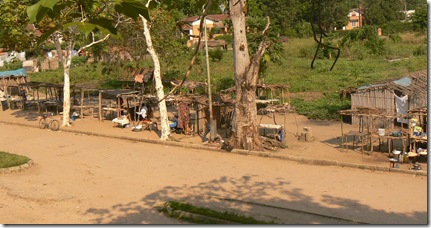On the outskirts of the large village of Bilomba, we seven pastors sat in an oblong semi-circle with the three children huddled closely together at the edge of the cement walkway of the school building. All questions were directed to the three. Each answered as he/she was asked. The three squirmed a bit in their obvious respect for authority. The night was black and the mood was solemn. Our interview of the three children was direct, completely serious, and apparently very necessary. The three children had been accused of mupongo (witchcraft) and had admitted their crime. Earlier that evening their older brother, Kabonga, had been interviewed as well, and had confessed. We prayed for these four children.
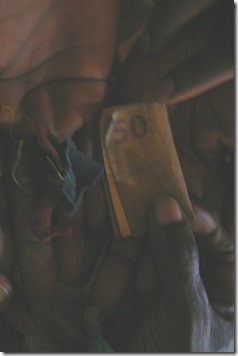 Kabonga confessed to giving 100 Congolese francs belonging to his father to a “muena mupongo” (witch) who
Kabonga confessed to giving 100 Congolese francs belonging to his father to a “muena mupongo” (witch) who
thus rendered Kabonga’s father incapable of finding work or finding money for the family; Kabongo also confessed to giving small pieces of
material from the clothing of his three younger siblings, thus giving the muena mupongo power to “eat” (metaphorically speaking) them,
‘eat’ meaning to have power over their lives and ultimately to kill them.
Mupongo is a dominating feature of the Kasaian worldview. Fear of mupongo and “bena mupongo” (those who practice withcraft) have a stranglehold upon the hearts and minds of the people. Because mupongo is an issue that wasn’t properly understood or sought to be understood by most missionaries who came to the Kasai of Congo, it was glossed over as “superstition.” Looking back, this reality is tragic. Missionaries who came with the Good News of the Gospel, news which has the power to set persons free from fear and every stronghold which enslaves, failed to deal with a central issue for the Kasai people. Modern western missions of the last two centuries, despite historic successes, often failed to take seriously indigenous cultures and worldviews. Since the Enlightenment Period, the western worldview valuing logic, reason, rationalism and the material world, has been perceived by westerners to trump all other understandings of reality. Looking back, this cultural hegemony has resulted in negative implications. One of which is a lack of understanding of mupongo in the Kasai, and how it affects the daily life of the people. According to Dr. Mulumba, General Secretary of the Congolese Presbyterian Church (CPC), the CPC is sadly ill-equipped to help persons and communities dealing with mupongo (a legacy from the missionary period). However, he and other church leaders who seek to give voice and understanding to their culture and their Kasaian worldview, have found constructive ways to minister to “mupongo bound” persons and to set them free in the Name of Jesus.
The day after the initial interview with the four children, we met with them along with their parents in their home. In front of their parents, the four children individually, one by one, renounced mupongo. We prayed for them, that God would remove this spirit. After two hours of continued interviewing, confessing and praying, we finished our time by praying for the family as a whole. While there was solemnity and seriousness throughout the entire duration, there was rejoicing at the end. I was impressed with this group of pastors with whom I ministered. They knew what they were doing, they acted with authority and humility, they gave dignity to the children and to their parents, and they served this family in a culturally-sensitive and pastoral way.
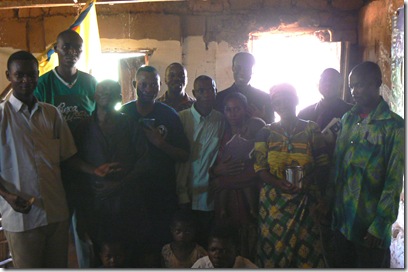 We pastors rejoiced with the family afterwards!
We pastors rejoiced with the family afterwards!
I will relate more about the specifics of the actual witchcraft beliefs of the Kasai people in another blog or newsletter. For now, let me say that the Bible cites the reality of evil in our world and evil’s multitudinous forms. Deuteronomy 18: 10, 11 gives the most explicit Old Testament prohibitions against sorcery, witchcraft, and divinatory activities. According to Dr. Mulumba who wrote his PhD disseration on witchcraft (Mulumba, 1988), those who practice such things break faith with God, and do not trust in him alone for guidance. Kasaians are very aware of the spiritual world and evil, and they have much to teach us as their worldview concerning the spiritual world lines up closer to the the biblical understanding of reality. Dr. Mulumba also makes the important concession that whether mupongo is scientifically real or imagined, Kasaian culture confirms it. Thus to relate meaningfully to Kasaian people in this area, it is best to have an “understanding heart to understand their problem of mupongo.” Such was my experience with the six pastors I ministered with in Bilomba.
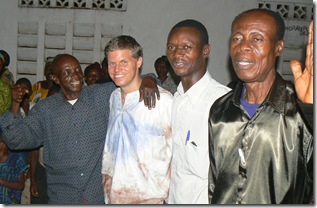 Pastors Kabaseli and Tshiwala (on my right), Elder Mukundi (on my left)
Pastors Kabaseli and Tshiwala (on my right), Elder Mukundi (on my left)
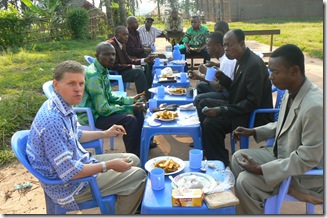 We spent three days ministering in Bilomba; here we are having breakfast Sunday morning before church.
We spent three days ministering in Bilomba; here we are having breakfast Sunday morning before church.
Everyone (except me) ate sardines every day!
There shall not be found among you any one who burns his son or his daughter as an offering, any one who practices divination, a soothsayer, or an auger, or a sorcerer, or a charmer, or a medium, or a wizard, or a necromancer…For these nations, which you are about to dispossess, give heed to soothsayers and diviners; but as for you, the Lord your God has not allowed you to do. (Deuteronomy 18: 10,11)






